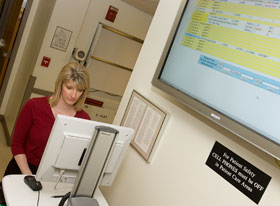  |
| HOME | THIS ISSUE | CALENDAR | GRANTS | BACK ISSUES | < BACK | NEXT > |
Computerization of emergency unit at Health Center improves efficiencyby Pat Keefe - May 1, 2006 |
||||
|
Health care has lagged behind other industries in terms of electronic capabilities, according to Dr. Robert Fuller, associate professor of traumatology and emergency medicine and medical director of the John Dempsey Hospital emergency department. “It’s about time medicine computerizes,” he says, “and gets to the place where most fancy restaurants are.” His Emergency Department is among those that are computerized. Doctors, nurses, and medical assistants in the ED no longer use paper records. But doing away with paper is only the beginning. The ED’s computer system records and stores patient information; maintains a permanent medical record; and has a risk management component that presents physicians with information diagrams, such as nerve paths or body parts. It also prompts for best medical practices, depending upon the complaint for which the patient is being treated; and sends reminders to medical staff about key tasks they shouldn’t forget. Billing is done automatically by the documentation the medical staff enter. The system also interfaces with several parallel systems so it can access a patient’s lifetime clinical record, stored electrocardiograms, or lab results. And it can perform an allergy check and advise on drug-to-drug interactions. The system has a display showing how long it has been since a patient arrived in the ED; when a nurse last went in to see a patient; the time the physician admitted or discharged a patient; and the length of the patient’s stay in the ED. “It’s spectacular,” says Linda Shanley, assistant vice president for clinical enterprise systems, the information technology liaison for the project. The system allows the physician to be at the bedside while evaluating a patient, order medications and nursing intervention, review previous visits and documentation, look at test results, and find old EKGs or new X-rays.
The John Dempsey Hospital as a whole is in the process of computerizing, but that system differs from the one in use in its ED. The ED’s system, developed by an emergency department physician, is specifically tailored to emergency medicine, emergency departments, and traumatology. The system was rolled out in phases, becoming fully operational in the fall. “It was a carefully thought-out and managed process,” says Shanley. “We had an enthusiastic team – Facilities Management, Info Tech, Nursing Administration, and of course the ED people – all bringing their brand of expertise to the table. Plus we had great vendor support.” The paperless system means improved efficiencies and streamlined work processes, says Kathleen Lundquist, nurse manager. “A computerized system for documentation is a huge advantage over a paper-based system,” she says. “In an electronic system, nothing gets lost. There’s no paper or charts to search for – you have access to the information you need instantly.” It also documents treatments more easily and more thoroughly, she says: “The accuracy and completeness of the record of what occurred is an unimaginable improvement over paper.” |
| ADVANCE HOME UCONN HOME |

